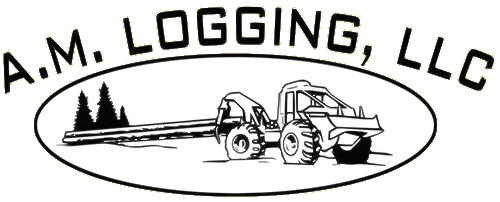Almost everyone is affected day-to-day by the logging industry. From the paper you use to the wood you burn; the wooden furniture in your home to the mulch in your flowerbeds: logging in Clearfield County directly affects you in one way or another. So, at A.M. Logging, we’re here to provide you with a comprehensive overview of logging, its significance and its various aspects.

What is Logging?
At its core, logging is the process of cutting down trees, processing the timber and transporting it to mills or markets. This seemingly straightforward definition belies a complex industry that plays a crucial role in our everyday lives. From the paper you write on to the wooden furniture in your home, many of the products we use daily originate from the logging industry.
The Importance of Logging
Logging is not just about cutting trees; it’s a critical industry that supports various sectors of the economy. Here are a few reasons why logging is so important:
- Economic Contribution: Logging generates significant revenue and provides employment opportunities in rural and forested areas. It supports industries like construction, furniture manufacturing and paper production while providing important revenue to forest landowners.
- Resource Management: With proper forest management, loggers can reduce the risk of forest fires, disease and pest infestations. Done well, logging can improve wildlife habitat, water and air quality.
- Sustainability: Modern logging practices emphasize responsible logging practices helping to manage and maintain forest health by selectively harvesting trees. This may include reforestation efforts, where new trees are planted to replace those that are harvested or harvesting so as to allow natural regeneration, ensuring a continuous supply of timber for future generations.
Types of Logging
There are several methods of logging, each suited to different environments and purposes:
- Clearcutting: This method involves removing all trees from a particular area. While efficient, it can be controversial due to its environmental impact. However, clearcutting can be beneficial in managing certain types of ecosystems and promoting new growth that is beneficial to certain wildlife. Early successional forests are vital habitat for our state’s bird, the Ruffed Grouse.
- Selective Logging: As the name suggests, this method involves selectively harvesting specific trees while preserving the overall structure of the forest. This can be a sustainable approach, reducing the ecological footprint. Done poorly, this method will lead to biodiversity loss and devaluation of the forest.
- Shelterwood Logging: This method involves removing trees in phases, allowing younger trees to grow under the protection of older ones. It helps maintain forest cover and supports biodiversity.
- Strip Logging: In this method, trees are harvested in narrow strips, leaving the surrounding forest largely intact. This can help minimize the visual and environmental impact of logging. Consider replacing this item with: Timber Stand Improvement: with this method, low value trees are harvested to allow preferred species to flourish. Think of this as weeding the garden.
Logging Equipment
Logging has come a long way from the days of manual axes and saws. Today, modern technology plays a pivotal role in making logging more efficient and safer. While this is certainly not an all-inclusive list of the equipment found on logging sites, it’s a good start to give you an idea of what to expect:
- Chainsaws: These are essential tools for felling trees and cutting timber to size. Modern chainsaws are powerful, lightweight and designed for precision.
- Harvesters: These machines can fell, de-limb and cut trees to length in a matter of seconds, significantly increasing productivity while drastically improving safety.
- Forwarders and Skidders: These vehicles are used to transport logs from the forest to a staging area where they can be loaded onto trucks.
- GIS: Geographic Information Systems (GIS) are increasingly used for mapping forests, planning logging operations and monitoring environmental impact.
Challenges in Logging
Despite its importance, the logging industry faces several challenges:
- Environmental Concerns: Logging can have significant environmental impacts, including habitat destruction and carbon emissions. Sustainable best management practices (BMPs) and stringent regulations are essential to mitigate these effects.
- Safety Risks: Logging is one of the most dangerous professions, with high rates of accidents and injuries. Proper training, safety gear and modern equipment are vital for protecting workers.
- Economic Pressures: Fluctuations in market demand and timber prices can affect the profitability of logging operations. Diversification and efficient management are key to sustaining businesses in this industry.
Logging is a multifaceted industry that blends tradition with modern technology. Its significance extends beyond the economic realm, influencing environmental stewardship and sustainable resource management. At A.M. Logging, we are committed to promoting responsible logging practices that balance economic needs with ecological considerations.
Thank you for joining us on this journey through the basics of logging. If you have any questions or are interested in scheduling logging services on your Clearfield County property, don’t hesitate to let us know. Call A.M. Logging today at 814-349-8089 or contact us!
